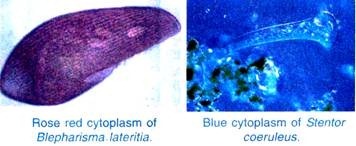In this essay we will discuss about:- 1. Stems of Lyginopteris Oldhamia 2. Fronds of Lyginopteris Oldhamia 3. Roots 4. Pollen-Bearing Organs 5. Seeds.
Essay # 1. Stems of Lyginopteris Oldhamia:
The frequently branched stem of Lyginopteris oldhamia was long, slender (2 mm to 4 cm in diameter). The anatomy of the stem (Fig. 1.2A) shows eustelic configuration with broad cortex bounded by a single epidermis. Small multicellular hairs are a common feature of the epidermis.
The cortex is divided into two zones: outer cortex with radial patches of sclerenchymatous cells resembling the Roman numerals on a clock face, and inner cortex which is parenchymatous. A ring of secondary wood with radially arranged multiseriate bordered-pitted tracheids is present.
The amount of wood is relatively small in proportion to the total size of the stem. Five strands of mesarch primary xylem are present inside the secondary wood. Leaf traces are present outside the stele. The pith is large and parenchymatous and possesses frequent clusters of small sclerotic cells forming sclerotic nests.
Heterangium (Fig. 1.3) is another stem genus associated with Sphenopteris leaf, reported from Lower and Upper Carboniferous deposits of Scotland. The stem is 2-4 cm in diameter which is rarely branched. The primary vasculature is of mixed protostele. A narrow band of secondary xylem is present outside the primary xylem. The secondary wood is similar to Lyginopteris oldhamia. The cortex is also divided into two zones like Lyginopteris oldhamia. The pith is large and reticulate.
Essay # 2. Fronds of Lyginopteris Oldhamia:
Bipinnate or tripinnate leaves of Sphenopteris hoeninghausii (Fig. 1.2B) are about 0.5m long which are arranged spirally on stem or branches. Leaves are borne at right angles to the rachis which show alternately arranged pinnules with free veins. The leaf anatomy shows a cutinised upper epidermis and mesophyll tissue divisible into palisade and spongy parenchyma. Leaf traces are formed by a tangential division of a primary xylem strand.
The trace separates into a pair of strands in the cortex that fuse at the base of the petiole (Rachiopteris aspera) to form a V-, Y- or W-shaped bundle. Petioles — when preserved as isolated fragments, with a V-, Y- or W-shaped bundle — are referred to as Lyginorachis.
Essay # 3. Roots of Lyginopteris Oldhamia:
Roots (Kaloxylon hookeri) are adventitious, aerial and long. T. S. of root shows an epidermis followed by a well-developed cortex. The cortex is divided into two zones: 2-3 layered parenchymatous outer cortex and a broad parenchymatous inner cortex with dense cytoplasmic content.
Inner cortex is secretory in nature, while outer cortex resembles velamen of orchids. The primary vasculature is polyarch showing radial arrangement with occasional reports on the occurrence of endodermis and pericycle.
Essay # 4. Pollen-Bearing Organs of Lyginopteris Oldhamia:
The male fructification, Crossotheca hoeninghausii (Fig. 1.2C) has been identified in association with the frond, Sphenopteris hoeninghausii. The fertile part of Crossotheca is spathulate or hastate bearing a number of boat-shaped, pendent, bilocular microsporangia that lack an annulus.
The whole structure resembles minute hair-brush or epaulets. Other pollen-bearing organs of this family are Telangium, Telangiopsis and Feraxotheca. In these form-genera pollen organs are synangiate with many pollen sacs arranged pinnately.
The pre-pollen of Lyginopteridaceae are spherical with trilete aperture, measuring about 70 pm in diameter.
Essay # 5. Seeds of Lyginopteris Oldhamia:
A large number of seeds or pre- ovules namely, Lagenostoma (Fig. 1.4A), Physostoma, Sphaerostoma, Conostoma, Lyrasperma, Stamnostoma, Eurystoma, etc. has been identified, of which Lagenostoma lomaxi (Fig. 1.4A, B) is better known.
Lagenostoma seeds are associated with ultimate part of Lyginopteris leaves which are about 5.5 mm in length and 4.25 mm in diameter. The seeds are covered with a protective covering called the cupule (Calymmatotheca hoeninghausii).
The cupules (Fig. 1.4A, B) are provided with numerous capitate glands. The ovule is orthotropus, barrel-shaped and is covered by an integument (outer stony and inner fleshy). Nucellus is fused with integument except at the apical chamber.
A ring of 8 to 9 vascular bundles are traversing the integument. Tip of the integument is divided in 9 parts, each receiving a vascular strand. The pollen chamber became more complex by the formation of a flask-shaped lagenostome due to the extended growth of nucellus (Fig. 1.4C). Trilete pre-pollens are occasionally found in pollen chamber.


